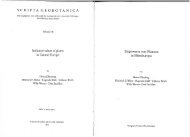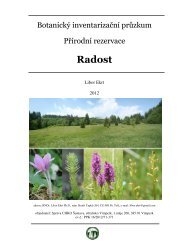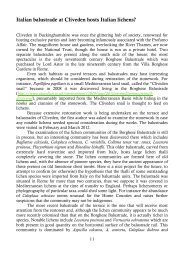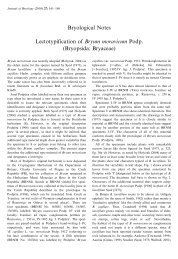Bryophyte flora of the Czech Republic: updated checklist and Red ...
Bryophyte flora of the Czech Republic: updated checklist and Red ...
Bryophyte flora of the Czech Republic: updated checklist and Red ...
Create successful ePaper yourself
Turn your PDF publications into a flip-book with our unique Google optimized e-Paper software.
838 Preslia 84: 813–850, 2012<br />
49 The genus Pleurochaete Lindb. is nested within Tortella (Grundmann et al. 2006).<br />
50 Among <strong>the</strong> varieties that are traditionaly recognized within Desmatodon latifolius, var. muticus (Brid.) Brid.)<br />
seems to represent a distinct taxon, as mixed st<strong>and</strong>s <strong>of</strong> clearly separable plants matching both varieties were<br />
observed in <strong>the</strong> <strong>Czech</strong> <strong>Republic</strong> (Mt Kotel) <strong>and</strong> in <strong>the</strong> Alps. However, we refrain at <strong>the</strong> moment from combining<br />
it within Tortula hoppeana, before <strong>the</strong> problem is addressed using molecular methods.<br />
51 Košnar & Kolář (2009) <strong>and</strong> Košnar et al. (2012) present arguments for accepting Tortula lingulata at <strong>the</strong> specific<br />
level, although this taxon is phylogenetically nested within T. muralis s.l. <strong>and</strong> its acceptance renders<br />
T. muralis paraphyletic in <strong>the</strong> strictly cladistic view.<br />
52 Tortula schimperi represents a taxon that earlier was mostly recognized as a variety <strong>of</strong> T. subulata. According<br />
to Cano et al. (2005), it deserves specific status. There is very little known about its distribution in <strong>the</strong> <strong>Czech</strong><br />
<strong>Republic</strong>, but recently two very small populations were recorded at two localities.<br />
53 While Hill et al. (2006) do not recognize var. angustifolium as distinct from Trichostomum crispulum, central-<br />
European authors (Grims 1999, Müller 2004) usually prefer to distinguish it as a distinct variety or even species.<br />
The revision <strong>of</strong> material in <strong>Czech</strong> herbaria (Kučera unpublished) at first did not reveal a taxon clearly<br />
separable from T. crispulum but recently JK realized that <strong>the</strong>re might be a distinguishable taxon matching this<br />
variety present in <strong>the</strong> <strong>Czech</strong> <strong>flora</strong>. This problem needs to be addressed in a taxonomic study.<br />
Discussion<br />
Changes in <strong>the</strong> <strong>checklist</strong>, <strong>and</strong> comparison with neighbouring countries <strong>and</strong> Europe<br />
The total number <strong>of</strong> accepted <strong>and</strong> evaluated taxa is 15 more than in <strong>the</strong> 2003 version. However,<br />
<strong>of</strong> <strong>the</strong>se <strong>the</strong>re are only 12 newly reported taxa for <strong>the</strong> <strong>Czech</strong> <strong>Republic</strong>, while 5 species<br />
appeared in <strong>the</strong> list in <strong>the</strong> result <strong>of</strong> a taxonomic reconsideration, <strong>and</strong> 8 previously listed<br />
under uncertain or taxonomically doubtful taxa have since been confirmed as occurring in<br />
<strong>the</strong> <strong>Czech</strong> <strong>Republic</strong>. On <strong>the</strong> o<strong>the</strong>r h<strong>and</strong>, 6 earlier recognized taxa are no longer included, 4<br />
have been moved to <strong>the</strong> ‘taxonomically doubtful’ <strong>and</strong> one to <strong>the</strong> ‘uncertain occurrence’<br />
category. From <strong>the</strong> user’s perspective, <strong>the</strong>re has unfortunately been a considerable number<br />
<strong>of</strong> name changes (136 taxa affected, i.e. 15.1%), caused by shifts into different genera (97<br />
taxa), taxonomic rank changes (16 taxa), or changes in (infra)specific epi<strong>the</strong>ts for mostly<br />
nomenclatural reasons (15 taxa). We corrected <strong>the</strong> author citation in 31 cases, although<br />
mostly only to conform to our ‘strategy’ <strong>of</strong> citing pre-Hedwigian moss names to that <strong>of</strong><br />
Hill et al. (2006). The number <strong>of</strong> genera increased from <strong>the</strong> 59 for liverworts <strong>and</strong> 175 for<br />
mosses, recognized in <strong>the</strong> 2003 version, to 76 <strong>and</strong> 194, respectively, as a consequence <strong>of</strong><br />
different generic concepts, mostly based on recent molecular phylogenetic treatments.<br />
The bryo<strong>flora</strong> <strong>of</strong> <strong>the</strong> <strong>Czech</strong> <strong>Republic</strong> (78, 867 km2 ) comprises roughly half <strong>of</strong> <strong>the</strong> European<br />
liverworts (423 species listed by Grolle & Long 2000) <strong>and</strong> mosses (1239 species<br />
accepted by Hill et al. 2006). The comparison <strong>of</strong> numbers with those in neighbouring<br />
countries is hampered by <strong>the</strong> fact that <strong>the</strong>y are ei<strong>the</strong>r significantly different in area, mostly<br />
larger (Germany, Pol<strong>and</strong>), or contain a significantly larger or smaller diversity <strong>of</strong> ecosystems.<br />
For example, <strong>the</strong> bryo<strong>flora</strong> <strong>of</strong> <strong>the</strong> state <strong>of</strong> Carinthia in Austria (9536 km2 ) exceeds<br />
that <strong>of</strong> <strong>the</strong> <strong>Czech</strong> <strong>Republic</strong> by some 30 species, having 893 species <strong>and</strong> 48 additional<br />
infraspecific taxa (Köckinger et al. 2008), while only 651 species <strong>of</strong> mosses are listed for<br />
<strong>the</strong> much larger (312,685 km2 ) but generally much less diverse Pol<strong>and</strong> (Ochyra et al.<br />
2003). Similarly, <strong>the</strong> area <strong>of</strong> Hungary (93,030 km 2 ) is similar to that <strong>of</strong> <strong>the</strong> <strong>Czech</strong> <strong>Republic</strong><br />
but <strong>the</strong> bryophyte <strong>flora</strong> <strong>of</strong> Hungary is only three quarters (659 bryophyte species plus 3<br />
subspecies – 2 hornwort, 146 liverwort <strong>and</strong> 511 moss species according to Papp et al.<br />
2010) <strong>of</strong> that <strong>of</strong> <strong>the</strong> <strong>Czech</strong> <strong>Republic</strong>, possibly because <strong>the</strong> smaller diversity <strong>of</strong> ecosystems<br />
<strong>and</strong> historically lower intensity <strong>of</strong> research on bryophytes in <strong>the</strong> former.










